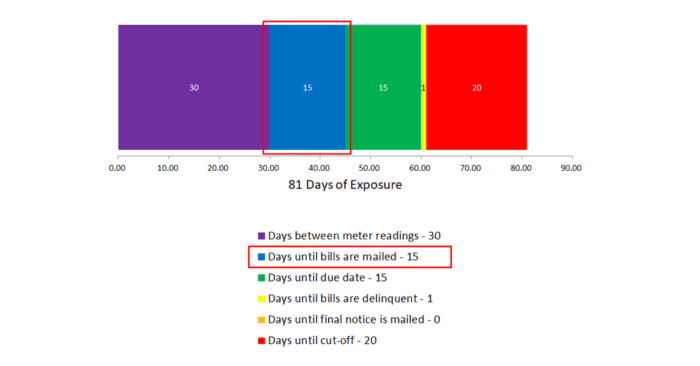During the Days of Exposure exercise portion of my Improving Revenue Collections for Utilities presentation at a recent speaking engagement, a couple of attendees inquired about the elapsed time between reading meters and mailing bills. This is actually low-hanging fruit when making an effort at reducing Days of Exposure, so let’s take a closer look.
What is Days of Exposure?
If you’ve heard me speak at a conference, subscribed to my newsletter, or followed my blog, you’re probably familiar with Days of Exposure. But, in case you’re not, let’s explore what it is.
Days of Exposure is a term I coined several years ago to determine a utility’s potential liability if a customer is turned off for non-payment and leaves without paying. It is the sum of the days between the previous reading for the bill your customer is being cut off for up until the day service is terminated. The total Days of Exposure is comprised of six components:
- Days between meter readings
- Days until bills are mailed
- Days until due date
- Days until bills are delinquent
- Days until final notice is mailed
- Days until cut-off
This article focuses on the second variable – the number of days between reading meters and mailing bills.
If you’re interested, you can calculate your utility’s Days of Exposure here.
An actual example
The Days of Exposure example shown above, which represents an actual utility, includes 15 days between reading meters and mailing bills. You can open a larger version of the image in a new window here.
As you can see, this particular utility takes 15 days between reading meters and mailing bills, which could be reduced. Unless they read meters by walking the routes, which I know they don’t, it shouldn’t take two weeks between reading meters and mailing bills.
How can this be improved?
As I mentioned above, this is one of the easier components to target when trying to reduce your Days of Exposure. It should only take a few days to review your meter reading exceptions to ensure the readings are accurate – not weeks.
Often, while conducting a business review, I find two primary reasons why this process takes longer than it should.
Lack of confidence in the billing software
Some utilities insist on visually checking every meter reading to look for high or low readings, rather than relying on meter reading exception reports produced by their billing software. This can add needless days to the billing process. If your billing software doesn’t provide sufficient tools, including accurate exception reports, to aid in identifying erroneous readings, maybe it’s time for new software!
Failure to capitalize on radio reading
Believe it or not, the primary reason utilities take too long between reading meters and mailing bills is they succumb to TTWWADI Syndrome. That’s the way we’ve always done it (or TTWWADI) after upgrading to radio read meters – whether drive-by or AMI – is a primary culprit.
Utilities that fall victim to this continue to start reading meters at the same time of the month as they did when they walked the routes. Radio read meters allow you to finish the reading process in a fraction of the time it used to, but many utilities still stick to the same schedule for starting reading and mailing bills. This results in days, or sometimes weeks, of wasted downtime.
How can we fix this?
If your utility suffers from either of these problems, please give me a call at 919-673-4050 or e-mail me at gary@utilityinformationpipeline.com to find out how a business review could help you find a solution.

© 2023 Gary Sanders
